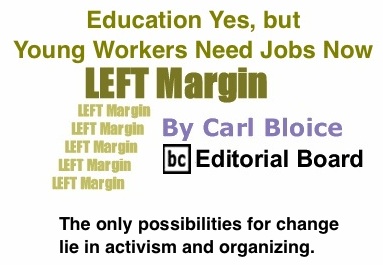




I was a wee lad when I first was told that figures can lie and
liars can figure. It was a caution to be careful when looking at
numbers. What brought that to mind the other day was a commentary “Why
the US is Looking to Germany for Answers,” by Financial Times U.S.
Correspondent, Edward Luce. Not that Luce is in any way untruthful;
he’s one of the most insightful and clear-headed major media observers
of the political economy of the United States today. But it was the
blown up quote on the piece that caught my attention: “Siemens recently
had 2,000 applications for 50 vacancies in North Carolina. Only 10 per
cent passed the aptitude test.” That means that 200 qualified workers
showed up to try out for 50 jobs. Luce didn’t speculate on how many
unqualified applicants would have turned out if the Siemens opening had
been in Stuttgart but that 1,800 people without the stipulated
qualifications thought they might land work at the plant is an
illustration of how desperate workers are in North Carolina where over
400,000 people are out of work and the February jobless rate was 9.4
percent. The same figure goes for the Charlotte-Gastonia-Rock Hill
metro area where Siemens has a plant and is looking for engineers. At
the beginning of the year, the jobless rate for African American in the
state stood at 17.3 percent.
“Not only did the state produce insufficient new jobs to bring down the
overall unemployment rate, but the industries experiencing the best
growth in an otherwise stagnant labor market are those industries that
pay lower than average wages,” said Allan Freyer, public policy analyst
with the Budget & Tax Center, a project of the North Carolina
Justice Center.
In February, the North Carolina state legislature reduced the maximum
weekly jobless relief check from $530 to $350 and set the duration of
benefits from 73 weeks to between 12 to 20 weeks, depending on the
unemployment rate. As a result of the action, an estimated 170,000
workers in the state will be denied Federal emergency unemployment
compensation, which is intended to aid the jobless when their state
benefits have been exhausted. “Hundreds of thousands of jobless workers
thrown out of work through no fault of their own will face deepening
poverty as a result of this decision,” said the Justice Center.
The situation in North Carolina is replicated in various parts of the
country - particularly in the South - and Luce’s observation about it
illustrates the seriously inadequate response to the unemployment
crisis and confusion about what has caused it.
Luce maintains that, “the US is underskilled” and “US
employers insist the shortage of skilled labor is a growing problem”
and “with the US participation rate continuing to plummet - last month
another 496,000 Americans gave up looking for work - many US
politicians are scouring Germany for answers.”
Luce noted that, “Germany channels roughly half of all high-school
students into the vocational education stream from the age of 16. In
the US that would be seen as too divisive, even un-American. More than
40 per cent of Germans become apprentices. Only 0.3 per cent of the US
labor force does so.” What he doesn’t say is that apprenticeships are
not unknown in the U.S. but their availability has greatly declined
over the years. Apprenticeship job training has largely been replaced
with limited on-the-job training, vocational classes, or community
college courses based on paid tuition.
And, one has only to look at joblessness in the construction trades,
where such programs do exist, to see that lacking skills is not the
primary reason why so many men and women are out of work.
New York Times columnist, Thomas Friedman, weighed in on the issue last
Sunday also citing the described dearth of skilled workers in North
Carolina and noted that “Today states are slashing budgets for
community colleges, just when every good job requires more skill.”
Luce reports that in North Carolina, Siemens is training six high
school dropouts to be “robot supervisors” at a cost of $165,000 each.
He is perhaps correct that the idea of channeling 40 percent of young
people into apprenticeships wouldn’t go over that well here. I’m not so
sure. But I can say with certainty that there are a lot of jobless kids
in my neighborhood who would welcome the opportunity to learn
“mechatronics,” a mixture of mechanical engineering and computer
science. Especially if there are jobs waiting for them when they finish
the course.
Of course nobody in a position to do so is proposing spending money on
an apprenticeship program that would engage jobless youth in Cleveland,
Detroit or Los Angeles; not the White House, not anyone in Congress.
But we are confronted with a much bigger problem than a lack of skills. Right now there just aren’t enough jobs to go around.
The Great Recession, and what has followed, “decimated job prospects
and earnings for young workers,” a new Economic Policy Institute (EPI)
briefing paper shows. In “The Class of 2013 young graduates still face
dim job prospects,” found researchers Heidi Shierholz, Natalie Sabadish
and Nicholas Finio. “For the fifth consecutive year, new graduates will
enter a profoundly weak labor market and will face high unemployment
and underemployment rates and depressed wages.”
“Because young workers always experience disproportionate increases in
unemployment during downturns, young workers have confronted
particularly high unemployment rates since the end of the Great
Recession,” reads the paper released April 10. “For young high school
graduates, the unemployment rate is 29.9 percent, compared with 17.5
percent in 2007, and the underemployment rate is 51.5 percent, compared
with 29.4 percent in 2007. For college graduates, the unemployment rate
is 8.8 percent, compared with 5.7 percent in 2007, and the
underemployment rate is 18.3 percent, compared with 9.9 percent in
2007.”
“Young workers have also seen their wages decline,” says the EPI.
“Between 2007 and 2012, the wages of young high school graduates
dropped 11.7 percent, and the wages of young college graduates dropped
7.6 percent. However, the wages of young graduates fared poorly even
before the Great Recession began, as most groups of young workers also
saw wage declines between 2000 and 2007. In all, between 2000 and 2012,
the wages of young high school graduates declined 12.7 percent, and the
wages of young college graduates decreased 8.5 percent. For full-time,
full-year workers, this represents a roughly $2,900 decline in annual
earnings for young high school graduates and a roughly $3,200 decline
for young college graduates.”
“While attaining additional educational is often identified as a
possible option for young people during periods of high unemployment,
there is no evidence of young workers ‘sheltering in school’,” the EPI
report says. “Since the start of the Great Recession, college and
university enrollment rates have not meaningfully departed from their
long-term trend for either men or women. In fact, though some students
have had the financial resources to take shelter in school, the lack of
substantial increase in enrollment suggests this group has been offset
by students who have been forced to drop out of school, or never enter,
because a lack of work meant they could not afford to attend.”
“Through no fault of their own, these young graduates are likely to
fare poorly for at least the next decade through reduced earnings,
greater earnings instability and more spells of unemployment,” said
Shierholz. “Instead of focusing on deficit reduction, policymakers
should be passing policies that will generate demand for U.S. goods and
services, and therefore demand for workers who provide them. This is
the key to giving young graduates entering today’s labor market a
fighting chance.”
A succinct and clarifying look at the relationship between unemployment
was proven last week by Sherry Linkon, co-director of the Center for
Working-Class Studies at Youngstown State University. In “Is Education
the Answer to Economic Inequality?” she wrote:
Linkon went on to cite commentary on how “colleges and
universities are failing to make those opportunities available, because
higher education has become too expensive and doesn’t do enough to help
lower-income students succeed.”
“On the basis of justice, we should be outraged,” wrote Linkon April
15, adding that, “We should join the thousands of college students who
have organized protests against cuts to public education. And
those of us who are educators should heed Mike Rose’s prescription for
addressing the needs of working-class students: ‘If we want more
students to succeed in college, then colleges have to turn full
attention to teaching’.”
“Still, the idea that more or better college education will ‘solve’ the
problem of economic inequality is just silly,” wrote Linkon.
“While a college education still provides economic advantages,
increasing lifetime income, achieving that benefit is harder than it
used to be. These days, getting a college degree doesn’t
guarantee better middle-class job prospects, but it does often bring a
lifetime of debt. Unemployment rates for recent graduates remain
high - 53 percent according to The Atlantic a year ago, and many have
taken low-wage, hourly jobs that don’t require a college degree.
Meanwhile, student loan debt has increased to an average of
$26,600. For too many, higher education has become a trap door
rather than an elevator.”
“I’m not suggesting that education isn’t worthwhile,” wrote Linkon.
“Far from it. A good education brings many advantages, only some
of which have to do with employment or income. Martha Nussbaum is just
one of many scholars arguing that education has value for society. But
education simply won’t address the root causes of today’s economic
inequality.
“First, while state legislatures and business organizations pressure
public universities to focus on preparing students for jobs in specific
fields, like health care or fracking, the widely-touted ‘skills gap’
turns out to be a myth. The American economy is not being stymied
by a lack of appropriately trained workers. Wharton School
management professor, Peter Cappelli, suggests that we should ‘Blame It
on the Employer.’ He suggests that employers ask themselves a few
key questions starting with this zinger: ‘Have you tried raising wages?
If you could get what you want by paying more, the problem is just that
you are cheap’.”
Linkon concludes that “even when we talk about increasing access or
establishing ‘universal’ programs, education addresses the individual,
not the system.”
“Even at its best, education helps some working-class young people
prepare to move into the middle class, an outcome that might improve
the economic opportunities of those individuals but doesn’t address the
broader economic structure,” wrote Linkon. “A thousand well-trained
nurses might earn a decent living, but they will work alongside aides,
janitors, and clerical workers who don’t. Simply put, moving some
people into better paying jobs doesn’t eliminate the low-wage jobs they
left behind.”
“Moreover, we should expect to see more low-wage jobs over time, not fewer, and education won’t change that.”
“If we want to improve the lives of low-wage workers and their
families, we need public policies that will create more jobs, increase
wages … and protect people from the financial ravages that often
accompany illness, natural disasters, and other devastating and
expensive events,” continued Linkon. “But how likely do you think it is
that our state or federal legislators will create such policies?”
In a new report
for Demos, “Stuck: Young America’s Persistent Jobs Crisis,” authors
Catherine Ruetschlin and Tamara Draut examine the state of the youth
employment today and find that while the overall economy is showing
signs of improvement, young workers are still in a state of crisis. In
an article described and made available on AFL-CIO Now April 15, they
warn that if policy isn’t changed to address the challenges young
people face, “we risk a generation marked by the insecurities of the
Great Recession for the rest of their working lives.”
“The only possibilities for change lie in activism and organizing,”
wrote Linkon. “And what does it take to foster resistance and
build solidarity? As our labor studies colleagues might remind
us, learning about economic, political, and social processes as well as
the history of activism, theories of class, and narratives of
oppression and resistance can prepare people to articulate and advocate
for their own interests and for the common good.”

BlackCommentator.com Editorial Board member and Columnist Carl
Bloice is a writer in





